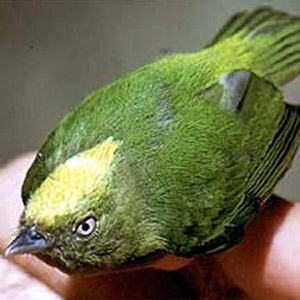Magazine | Études
Redécouverte du Manakin doré au Brésil

Manakin doré (Lepidotrix vilasboasi) mâle, Consórcio Jamunxim, Novo Progresso, Pará méridional, Brésil. Photographie : Fábio Olmos
Introduction
Le Manakin doré (Lepidotrix vilasboasi) est une espèce énigmatique connue seulement il y a encore peu de temps par trois mâles adultes capturés en 1957 au sud de l’état brésilien de Pará, au centre-sud de la forêt amazonienne. Son nom latin a été donné en honneur des frères Villas-Boas, deux explorateurs qui ont travaillé sur les tribus indiennes du centre de l’Amazonie et qui ont contribué à la création du Parque Indígena do Xingu. En mai 2002, Fábio Olmos du BirdLife International Brasil Programme et José Fernando Pacheco du Comitê Brasileiro de Registros Ornitológicos ont redécouvert un mâle de Manakin doré près de la ville de Novo Progresso, dans un secteur en cours de colonisation et donc soumis à une destruction rapide.
Les auteurs de cet article, publié dans la revue Cotinga et dont nous vous proposons une version française, espèrent que leur trouvaille contribuera à protéger des portions de cette zone forestière.
Abstract
The Golden-crowned Manakin Lepidotrix (formerly Pipra) vilasboasi is an enigmatic species known only from three adult males, collected by Helmut Sick and Raimundo Costa in July 1957 near a small left bank tributary at the headwaters of the rio Cururu, a tributary at the right margin of the rio Teles Pires. The species is considered Vulnerable. The range of L. vilasboasi has been subject to some confusion, as there are two rios Cururu along the right bank of the rio Teles Pires. It has been suggested that L. vilasboasi occurs in a belt between the rios Tapajós and Xingu, but this is hypothetical. The lack of recent records and the seemingly restricted range between that of L. nattereri gracilis and Opal-crowned Manakin L. iris eucephala prompted the suggestion that vilasboasi is a hybrid between the two.
In May 2002, Fábio Olmos from the BirdLife International Brasil Programme and José Fernando Pacheco du Comitê Brasileiro de Registros Ornitológicos conducted an ornithological survey of areas along the Cuiabá–Santarém road, an earthen strip running from northern Mato Grosso to the right bank of the Amazon in Pará. Early in the morning of 14 May, JFP observed an adult male L. vilasboasi perched near the ground on a fallen branch beside a dirt road with some vehicle traffic. We p^ropose you a French version ot their article published in the Cotinga Journal.
Poursuivez la lecture de cet article, en vous abonnant dès maintenant !
Découvrez les Archives d’Ornithomedia.com
Pour seulement 10,00 €TTC/an (ou 6,00 € les 6 mois)
Profitez de plusieurs centaines d’articles en accès illimité et sans aucun engagement.
Compléments
Auteurs
Fábio Olmos (BirdLife International Brasil Programme) et José Fernando Pacheco (Comitê Brasileiro de Registros Ornitológicos)
À lire aussi sur Ornithomedia.com
- Description d’une nouvelle sous-espèce du Mérulaxe de Rodriguez
- Pete Hosner et la découverte du Mérulaxe de Junín ou de Getty
- Description d’une nouvelle espèce d’oiseau au Pérou, le Mérulaxe de Junín ou de Getty
- Description d’un nouveau taxon, le Mérulaxe des rochers
- Découverte d’une nouvelle sous-espèce du Mérulaxe du matorral
- Révision de la taxonomie du Mérulaxe du páramo
- Expédition ornithologique dans l’état de Bahia (Brésil) en avril 2008




Aucun commentaire sur ce sujet
Participer à la discussion !